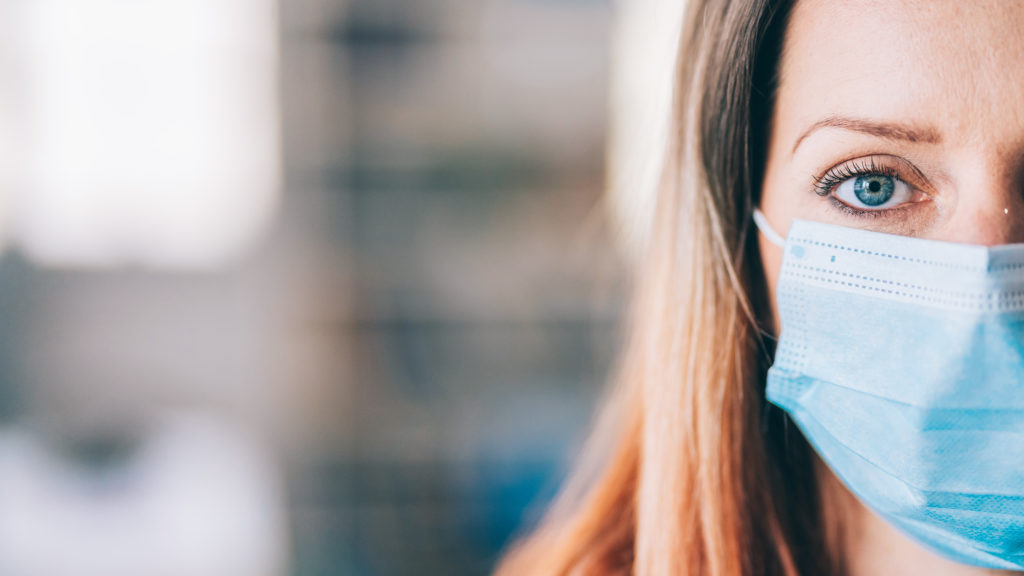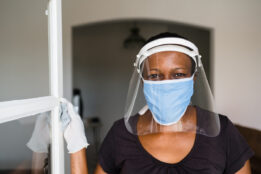COVID-19 and Your Eyes: Tips for Protecting Your Vision During the Pandemic

The situation with the COVID-19 pandemic and the virus variants, including the Delta variant that is proving to be highly transmissible and potentially more lethal, is dynamic. Fortunately, vaccines now have full FDA approval, having demonstrated their effectiveness against illness. However, infection rates are currently on the rise, and public health officials are urging people to get vaccinated and continue with protective measures. We are working to share with you accurate, evidence-based information about the potential impact COVID-19 has on the health of your eyes and vision. As always, anyone concerned about their symptoms should call their eye doctor.
Eye Infections May Be A Rare Symptom of COVID-19
Studies of the COVID-19 outbreak have found a few patients develop conjunctivitis, more commonly known as “pink eye.” All cases of pink eye require the attention of a doctor. If you develop symptoms: pain, irritation, redness, and swelling of the eye, contact your eye doctor. Depending upon other symptoms (fever, cough, shortness of breath), it may be an indication of coronavirus infection.
Allergies versus Coronavirus
Symptoms of coronavirus have been described in minute detail in the media: Fever, coughing, and shortness of breath. But for seasonal allergy sufferers, it can be tough to sort out what is pollen, panic, or perhaps something more serious. Importantly, allergies don’t typically cause fever. While the itchy eyes, runny nose, and sneezing commonly associated with allergies may lead to some coughing and wheezing, those symptoms are usually managed with an antihistamine. Most cases of coronavirus are mild to moderate, similar to a cold. Rest, managing fever and other symptoms as needed with over-the-counter medications, and keeping hydrated are generally recommended. More severe cases include shortness of breath, which requires urgent professional medical attention.
Safe at Home Orders Mean More Time with Devices
Social distancing practices have many people leveraging technology to work, attend classes and keep themselves entertained. This translates to more time than ever in front of computers, tablets, and mobile phones. While these devices have become an integral part of life today, the long hours of screen time can take a toll on eyes and vision. In this time when everyone is feeling a bit stressed out, it is important to take advantage of simple methods of self-care. To avoid digital eye strain follow the 20-20-20 rule: take a 20-second break every 20 minutes and gaze at something 20 feet away.
Personal Hygiene for Eyewear
The first step in any personal hygiene is washing your hands. The global health crisis has everyone evaluating their personal hygiene and washing your hands begins to take up far more of your day than ever before. For those who rely on eyeglasses or contact lenses to see well, there’s a longer “to do” list to keep yourself safe and healthy. This list includes cleaning your eyeglasses and contact lens gear – all of which should be done after, you guessed it, you wash your hands:
- For glasses, a microfiber cloth is the tool of choice for removing grime and grease from your glasses. Gently but thoroughly wash frames with soap and water or an eyeglass cleaner with disinfecting ingredients to help eliminate germs.
- Contact lens wearers should be diligently adhering to hygiene practices, including keeping contact lens cases clean by rinsing it with contact lens solution. Using fresh solution, wearing contacts for an appropriate length of time, not sleeping in contacts and making sure hands are freshly washed before and after touching your eyes are also important. Check out the CDC recommendations for healthy contact lens care.
As always, your eye doctor is your eye health expert and if you have any questions or concerns about your eyes or vision, it is important to reach out and call the office. More eye doctors are offering telehealth or virtual eye care visits to help with social distancing in the office and to help patients stay on top of their overall eye health and wellbeing. If it has been more than a year since your last eye exam, make the time for an appointment with an ophthalmologist. If you don’t currently have an eye doctor, use our find-a-doctor feature or ask your primary care physician for a referral.




